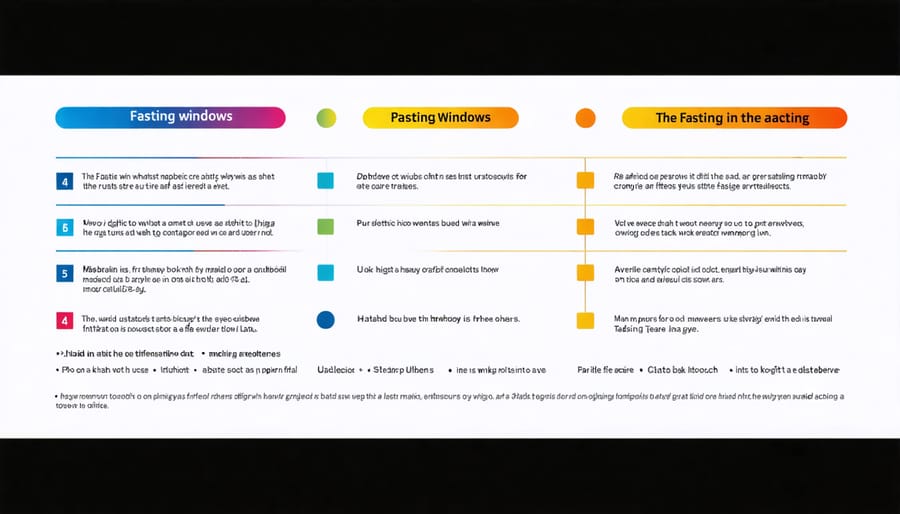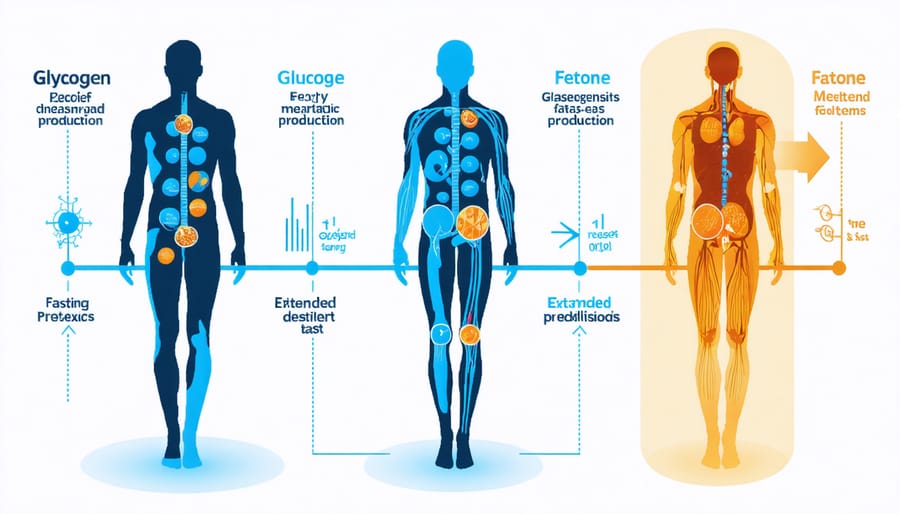Metabolism stands at the core of our body’s energy production and utilization system, orchestrating a complex dance between carbohydrates, fats, and proteins. Through intermittent fasting and other dietary patterns, we can optimize how our bodies process these essential nutrients. Each macronutrient plays a distinct yet interconnected role: carbohydrates provide quick energy for immediate use, fats offer sustained fuel reserves, and proteins maintain our body’s structural integrity while supporting enzyme production.
Understanding this metabolic trinity helps explain why balanced nutrition matters for everything from maintaining steady energy levels to supporting muscle growth and recovery. When we eat, our bodies immediately begin breaking down these nutrients through specialized pathways, converting them into forms our cells can use. This process powers every aspect of our daily lives – from basic cellular functions to intense physical activity.
Recent research reveals how these metabolic pathways adapt to our eating patterns and lifestyle choices, suggesting that timing our meals and choosing the right balance of nutrients can significantly impact our health outcomes. This fundamental understanding of metabolism serves as the foundation for making informed dietary decisions that support our overall well-being.
The Metabolic Switch: How Fasting Changes Your Body’s Energy Source
The Fed State vs. The Fasted State
Your body operates differently depending on whether you’re regularly eating or fasting. During the fed state, which occurs after meals, your body focuses on processing and storing nutrients. Insulin levels rise, promoting the absorption of glucose into cells and the storage of excess energy as fat. This is when your body actively builds and repairs tissues using available proteins and nutrients.
The metabolic changes during fasting create a distinct environment in your body. After about 8-12 hours without food, insulin levels drop, and your body shifts to using stored energy. It begins breaking down glycogen (stored glucose) from the liver and muscles. Once these stores diminish, your body turns to fat for energy, producing ketones as an alternative fuel source.
This metabolic flexibility is natural and beneficial for health. The alternating cycles between fed and fasted states help maintain healthy blood sugar levels, support cellular repair processes, and can improve insulin sensitivity. Understanding these patterns can help you make informed decisions about meal timing and fasting periods to optimize your metabolic health.
Timing of Metabolic Transitions
Your body goes through several distinct metabolic shifts during fasting periods. In the first few hours after eating, your body primarily uses glucose from your last meal for energy. Around 4-6 hours later, blood sugar levels begin to drop, and your body starts tapping into glycogen stores in your liver.
By the 12-hour mark, most glycogen stores are depleted, triggering your body to increase fat burning for energy. This process, known as fat adaptation, becomes more efficient between 16-24 hours of fasting. During this time, your body produces ketones from stored fat to fuel your brain and other organs.
After 24 hours, protein breakdown slightly increases to maintain blood sugar levels through gluconeogenesis. However, your body becomes more efficient at preserving muscle tissue as fasting continues. The most significant metabolic benefits, including enhanced fat burning and cellular repair, typically occur between 16-36 hours of fasting.
These transitions happen naturally and become more efficient with regular fasting practice. Understanding this timeline can help you choose fasting periods that align with your health goals.

Carbohydrate Metabolism During Fasting
Glycogen Depletion and Blood Sugar Regulation
When you stop eating, your body initiates a remarkable process to maintain steady blood sugar regulation. During the first few hours without food, your body taps into its glycogen stores – mainly found in the liver and muscles – to keep blood glucose levels stable. Think of glycogen as your body’s emergency energy savings account.
As glycogen stores begin to diminish, typically after 12-24 hours of fasting, your body becomes increasingly efficient at using alternative fuel sources. The liver steps up its glucose production through a process called gluconeogenesis, creating glucose from non-carbohydrate sources like amino acids and fatty acids.
This metabolic shift helps protect your vital organs, particularly your brain, which primarily runs on glucose. Your muscles also adapt by using more fatty acids for energy, preserving the limited glucose for organs that need it most. This natural process explains why humans can maintain stable blood sugar levels even during extended periods without food.
Understanding this process is crucial for anyone interested in intermittent fasting or managing their energy levels throughout the day. It demonstrates your body’s remarkable ability to adapt and maintain balance, even when food isn’t readily available.
Gluconeogenesis: Creating Glucose When Needed
When your body needs glucose but carbohydrates aren’t available, it turns to a remarkable process called gluconeogenesis. This metabolic pathway creates new glucose molecules from non-carbohydrate sources, primarily amino acids from proteins and glycerol from fats. Your liver is the main site for this process, though your kidneys can also participate when necessary.
Think of gluconeogenesis as your body’s backup energy plan. It’s especially active during periods of fasting, intense exercise, or when following a low-carb diet. Your body converts substances like lactate, pyruvate, and certain amino acids into glucose to maintain stable blood sugar levels and provide energy to glucose-dependent organs, particularly your brain.
This process is carefully regulated by hormones, with glucagon promoting gluconeogenesis and insulin suppressing it. This balance ensures your blood glucose stays within a healthy range even when you’re not consuming carbohydrates.
For most people, gluconeogenesis happens naturally without any conscious effort. However, athletes and individuals following specific dietary patterns may experience increased gluconeogenesis as their bodies adapt to different energy demands or reduced carbohydrate intake.
Fat Metabolism in the Fasted State
Accessing Fat Stores
When your body needs energy and carbohydrate stores are depleted, it begins to access stored fat through a process called lipolysis. During this process, fat cells (adipose tissue) release fatty acids into the bloodstream. These fatty acids travel to the liver, where they’re broken down into smaller molecules called ketones.
This fat-burning process becomes particularly active during extended periods without food, such as overnight fasting or during exercise. Your body releases hormones like glucagon and epinephrine, which signal fat cells to release their stored energy. The liver then processes these fatty acids through beta-oxidation, creating energy that can fuel various body functions.
For most people, accessing fat stores becomes more efficient after about 12 hours of fasting. This is why many health experts suggest limiting late-night snacking – it gives your body a better opportunity to tap into fat reserves during your natural overnight fast.
Regular physical activity helps improve your body’s ability to access and use stored fat for energy. This adaptation is particularly beneficial for endurance activities and maintaining stable energy levels throughout the day.

Ketone Production and Usage
When your body’s glucose levels drop, it triggers a remarkable process called ketogenesis. During this process, your liver breaks down stored fat to produce ketones, which serve as an alternative energy source for your brain, heart, and muscles. This shift typically occurs during extended periods without food, intense exercise, or when following a very low-carbohydrate diet.
Your body produces three main types of ketones: acetoacetate, beta-hydroxybutyrate, and acetone. These molecules are water-soluble, allowing them to easily travel through your bloodstream to reach organs and tissues that need energy. What’s particularly fascinating is that some organs, like your brain, can use ketones almost as efficiently as glucose for fuel.
The process of adapting to using ketones for energy usually takes a few days to weeks. During this transition, you might notice changes in your energy levels and mental clarity. Many people report feeling more focused and experiencing stable energy levels once their bodies become efficient at using ketones.
It’s important to note that while ketone production is a natural and healthy process, it should occur gradually and under appropriate circumstances. Your body maintains a careful balance, producing just enough ketones to meet your energy needs while preventing excessive buildup.
Protein Metabolism While Fasting
Protein Preservation Mechanisms
During periods of fasting, your body has several built-in mechanisms to protect muscle mass while still maintaining essential functions. The process begins with the release of hormones like human growth hormone (HGH) and norepinephrine, which help preserve muscle tissue while promoting fat burning for energy.
Your body becomes more efficient at using stored fat for fuel, a process known as fat adaptation. This helps spare protein from being broken down for energy. Additionally, autophagy kicks in, where your body breaks down damaged cellular components while preserving healthy muscle tissue.
The preservation of muscle mass is further supported by maintaining adequate protein intake during eating windows and staying physically active. Light exercise during fasting periods can actually enhance these protective mechanisms. Proper hydration and electrolyte balance also play crucial roles in maintaining muscle function and preventing protein breakdown.
It’s important to note that these protective mechanisms work best during short-term fasting periods of up to 24-72 hours. Beyond this timeframe, different metabolic adaptations may occur, and additional strategies may be needed to maintain muscle mass effectively.
Essential Amino Acid Management
During fasting, your body carefully manages essential amino acids to maintain vital functions. When food isn’t available, your muscles serve as a protein reservoir, releasing these crucial building blocks into your bloodstream as needed. This process helps preserve brain function and supports important metabolic processes throughout your body.
Your liver plays a key role in this management system by breaking down some amino acids while conserving others. It prioritizes keeping essential amino acids available for critical tasks like maintaining your immune system and producing important hormones. This selective preservation helps protect your body’s core functions even during extended periods without food.
To minimize muscle breakdown during fasting, your body becomes more efficient at recycling existing proteins. It breaks down damaged or unnecessary proteins first, saving structural and functional proteins for as long as possible. This smart conservation strategy helps protect your muscle mass while ensuring your body has access to the essential amino acids it needs.
When you resume eating, your body quickly switches back to normal amino acid processing, efficiently using the new protein supply to rebuild and repair tissues.
Practical Applications for Optimal Metabolic Health
Finding Your Optimal Fasting Window
Finding your ideal fasting window is a personal journey that depends on your lifestyle, health goals, and daily schedule. Start by experimenting with a 12-hour overnight fast, which simply means stopping eating after dinner and having breakfast 12 hours later. This gentle approach allows your body to adjust gradually to fasting while still supporting essential metabolic processes.
If you feel comfortable with 12 hours, you might consider extending your fasting window to 14 or 16 hours. Pay attention to your energy levels, hunger cues, and overall well-being during this transition. Some people find they function best with a 16:8 schedule (fasting for 16 hours and eating within an 8-hour window), while others prefer a shorter fasting period.
Consider your daily routine when choosing your fasting window. If you exercise in the morning, you might want to schedule your eating window to begin shortly after your workout. For those who enjoy family dinners or social events in the evening, an earlier eating window might be more challenging.
Track your progress and note how different fasting schedules affect your mood, concentration, and physical performance. Remember that flexibility is key – your optimal fasting window may change based on your work schedule, season, or other life circumstances. Start slowly, listen to your body, and adjust your fasting schedule as needed to find what works best for you.

Supporting Healthy Metabolism During Fasts
When fasting, it’s crucial to support your body’s metabolic processes while maintaining a healthy hormone balance during fasting. Start by staying well-hydrated with water, herbal teas, and electrolyte-rich beverages. This helps maintain essential metabolic functions and energy levels throughout your fast.
Focus on nutrient-dense foods during your eating windows. Include lean proteins, healthy fats, and complex carbohydrates to provide your body with the building blocks it needs for optimal metabolism. Foods like eggs, fatty fish, leafy greens, and whole grains are excellent choices.
Consider timing your fasts around your natural circadian rhythm. Many people find success with early dinner times and delayed breakfast, which aligns with our body’s natural metabolic patterns. This approach can help optimize fat burning and preserve muscle mass.
During fasting periods, gentle movement like walking or stretching can help maintain metabolic activity without overtaxing your system. However, avoid intense exercise during extended fasts, as this may stress your body unnecessarily.
Break your fast thoughtfully with easily digestible foods. Start with small portions of protein-rich foods and gradually introduce other nutrients. This approach helps prevent digestive discomfort and supports your body’s transition back to its fed state.
Pay attention to your body’s signals and adjust your fasting schedule accordingly. Some people may need shorter fasting windows or more frequent eating days to maintain optimal metabolic health.
Understanding the metabolism of carbohydrates, fats, and proteins is crucial for maintaining optimal health and energy levels. These nutrients work together in a complex yet harmonious system that keeps our bodies functioning properly. By maintaining a balanced diet rich in whole foods, staying physically active, and getting adequate rest, you can support your body’s natural metabolic processes. Remember to listen to your body’s signals and adjust your eating patterns accordingly. If you have specific health concerns or conditions, consult with a healthcare provider to develop a personalized nutrition plan that supports your metabolic health. Making informed choices about your diet and lifestyle can help you maintain steady energy levels, support weight management, and promote overall well-being.

